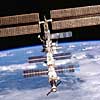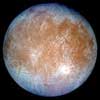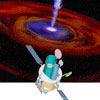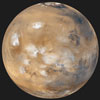|
Sunday:
January 20, 2002 | |
0022 GMT |
 |
Space station research to study liver treatments
NASA has signed an agreement with StelSys LLC, Baltimore, to fly experiments on the International Space Station that will compare human liver-cell function in space with that on Earth. This research could aid in StelSys' development of treatment for people in need of liver transplants.
 FULL STORY FULL STORY
 |  |

|
 |
Growth of greenhouse emissions have slowed
A new NASA-funded study shows that the rate of growth of greenhouse gas emissions has slowed since its peak in 1980, due in part to international cooperation that led to reduced chlorofluorocarbon use, slower growth of methane, and a steady rate of carbon dioxide emissions.
 FULL STORY FULL STORY
 |  |

|
 |
DAILY BRIEFING Other stories making news today
|
 |
Hybrid rocket motor completes test at Stennis -- The John C. Stennis Space Center completed the fourth in a series of large-scale hybrid motor tests this past week. The 250,000-pound thrust hybrid rocket motor tested capitalizes on the safety and operational features of a liquid-propulsion system with the cost-savings potential of an inert solid propulsion system.
|
 |
|
Saturday:
January 19, 2002 | |
0141 GMT |
 |
Scientists apply knowledge of Earth to study Europa
The size of ice domes and movement of ice rafts on the surface of Europa, one of Jupiter's moons, are consistent with what one could expect of melting caused by a hydrothermal vent plume, or plumes, in an ocean beneath the ice, two oceanographers say.
 FULL STORY FULL STORY
 |  |

|
 |
Ground controllers coax Galileo out of hibernation
NASA's Galileo spacecraft was revived Friday in time to snap a few final images of landmarks in the Jovian system, but its last close encounter with Io was a bust because an onboard glitch put the probe into hibernation just minutes before the flyby Thursday.
 FULL STORY FULL STORY
 EARLIER STORY EARLIER STORY
 PREVIEW OF IO FLYBY PREVIEW OF IO FLYBY
 |  |

|
 |
|
Friday:
January 18, 2002 | |
0422 GMT |
 |
Trouble sends Galileo into hibernation during Io flyby
The Galileo probe orbiting Jupiter ran into problems Thursday as the spacecraft neared its final close encounter with the moon Io. Similar to glitches suffered in the past, this most recent event prevented any observations from taking place during the closest part of the flyby.
 FULL STORY FULL STORY
 PREVIEW OF IO FLYBY PREVIEW OF IO FLYBY
 |  |

|
 |
Mars probe tweaks orbit around the Red Planet
NASA's Mars Odyssey spacecraft completed two maneuvers this week, fine-tuning its orbit in preparation for the science mapping mission that will begin in late February.
 FULL STORY FULL STORY
 ODYSSEY COMPLETES AEROBRAKING ODYSSEY COMPLETES AEROBRAKING
 |  |

|
 |
Station crew follows spacewalk with lung tests
The Expedition Four crew wrapped up its orbital construction duties this week with a science experiment to measure how well the crew's lungs function following exposure to the low pressure environment of their spacesuits as well as exposure to the confined atmosphere of the Space Station.
 FULL STORY FULL STORY
 |  |

|
 |
|
Thursday:
January 17, 2002 | |
0551 GMT |
 |
Discoveries raise hopes, questions about life on Mars
Two separate studies published Thursday both provided new evidence that life could exist on the planet Mars while raising questions about the validity of some of the evidence presented for Martian life.
 FULL STORY FULL STORY
 UMASS NEWS RELEASE UMASS NEWS RELEASE
 ESA NEWS RELEASE ESA NEWS RELEASE
 |  |

|
 |
Easy method for estimating mass of distant black holes
An Ohio State University astronomer has developed a method for reliably estimating the mass of black holes in distant quasars. Based on this method, Marianne Vestergaard, a postdoctoral astronomy researcher at Ohio State, has begun to address the longstanding issue of why only a small fraction of quasars are capable of producing very powerful radio emission.
 FULL STORY FULL STORY
 |  |

|
 |
Ohio State proposes 'Kronos' space observatory
In the not-too-distant future, an Ohio State-inspired satellite observatory could be orbiting high above the earth, watching black holes feast on far-away galaxies.
 FULL STORY FULL STORY
 |  |

|
 |
|
Wednesday:
January 16, 2002 | |
0923 GMT |
 |
Milstar satellite launched in first space shot of 2002
The U.S. military on Tuesday launched the final link that will form a "golden ring" of communications satellites around Earth, providing ultra-secure, jam-resistant transmissions for troops and government leaders virtually anywhere on the planet.
 FULL STORY FULL STORY
 MISSION STATUS CENTER MISSION STATUS CENTER
 |  |

|
 |

Video coverage for subscribers only:

 PANORAMA: 360-DEGREE VIEW OF ROCKET ON THE PAD QT VR PANORAMA: 360-DEGREE VIEW OF ROCKET ON THE PAD QT VR
 VIDEO: TITAN 4 ROCKET BLASTS OFF WITH MILSTAR 5 QT or RV VIDEO: TITAN 4 ROCKET BLASTS OFF WITH MILSTAR 5 QT or RV
 VIDEO: MILSTAR IS ENCLOSED BY TITAN NOSE CONE QT or RV VIDEO: MILSTAR IS ENCLOSED BY TITAN NOSE CONE QT or RV
 VIDEO: SERVICE TOWER RETRACTED FOR LAUNCH QT or RV VIDEO: SERVICE TOWER RETRACTED FOR LAUNCH QT or RV
 MORE: COMPLETE SFN+ VIDEO INDEX MORE: COMPLETE SFN+ VIDEO INDEX

|
Galileo heads for final flyby of Jupiter's moon Io
NASA's Galileo orbiter will dart past Jupiter's moon Io on Thursday in the veteran spacecraft's last and closest flyby of any of the giant planet's four major moons. The spacecraft Galileo is aimed to skim just 62 miles above Io's multicolored surface.
 FULL STORY FULL STORY
 |  |

|
 |
|
Tuesday:
January 15, 2002 | |
0400 GMT |
 |
Air Force Titan 4 rocket poised to launch Tuesday
The first space launch of 2002 remains set to go Tuesday when America's most powerful rocket - the Lockheed Martin-built Titan 4B - blasts off from Cape Canaveral carrying a vital Milstar communications satellite for the U.S. government.
 MISSION STATUS CENTER MISSION STATUS CENTER
 LAUNCH EVENTS TIMELINE - updated LAUNCH EVENTS TIMELINE - updated
 TITAN 4 ROCKET FACT SHEET TITAN 4 ROCKET FACT SHEET
 MILSTAR SATELLITE FACT SHEET MILSTAR SATELLITE FACT SHEET
 |  |

|
 |
Antarctic microbes suggest life is possible on Mars
Canadian and New Zealand scientists have found living microbes buried deeper than perhaps ever before in Antarctica's ice-free Dry Valleys. They and collaborating planetary scientists at the University of Arizona say new research "opens up the possibility of life on Mars and the possible positions within a soil where it might be found."
 FULL STORY FULL STORY
 |  |

|
 |
Space station Alpha spacewalk a success
The first spacewalk by the current crew of the International Space Station was successfully completed Monday as a Russian cosmonaut and an American astronaut conducted a six-hour excursion to move a cargo crane and install an amateur radio antenna.
 MISSION STATUS CENTER MISSION STATUS CENTER
 |  |

|
 |

Video coverage for subscribers only:

 VIDEO: DETAILED PREVIEW OF THE SPACEWALK QT or RV VIDEO: DETAILED PREVIEW OF THE SPACEWALK QT or RV
 VIDEO: UPDATE ON STATION SCIENCE EXPERIMENTS QT or RV VIDEO: UPDATE ON STATION SCIENCE EXPERIMENTS QT or RV
 MORE: COMPLETE SFN+ VIDEO INDEX MORE: COMPLETE SFN+ VIDEO INDEX

|
Project planned to pin down moon's distance from Earth
Tom Murphy plans to spend much of the next five years using the Apache Point
telescope in New Mexico as a tape measure 239,000 miles long - give or take
a millimeter. He'll employ the telescope, a laser beam and reflectors left by several lunar missions in a technique known as laser ranging to provide the most exacting measure yet of the Earth's distance from the moon.
 FULL STORY FULL STORY
 |  |

|
 |
|
Monday:
January 14, 2002 | |
0635 GMT |
 |
Spacewalk scheduled for station crew Monday
The first spacewalk by the current crew of the International Space Station will be staged Monday as a Russian cosmonaut and an American astronaut conduct a six-hour excursion to move a cargo crane and install an amateur radio antenna.
 MISSION STATUS CENTER MISSION STATUS CENTER
 |  |

|
 |

Video coverage for subscribers only:

 VIDEO: DETAILED PREVIEW OF THE SPACEWALK QT or RV VIDEO: DETAILED PREVIEW OF THE SPACEWALK QT or RV
 VIDEO: UPDATE ON STATION SCIENCE EXPERIMENTS QT or RV VIDEO: UPDATE ON STATION SCIENCE EXPERIMENTS QT or RV
 MORE: COMPLETE SFN+ VIDEO INDEX MORE: COMPLETE SFN+ VIDEO INDEX

|
New oceanography satellite achieves proper orbit
The joint NASA/French Space Agency oceanography satellite Jason 1 has reached its operational orbit and begun six months of instrument calibrations with its sister spacecraft, Topex/Poseidon.
 FULL STORY FULL STORY
 JASON 1 LAUNCH COVERAGE JASON 1 LAUNCH COVERAGE
 |  |

|
 |


 Astronomy Now and Spaceflight Now present a 100-page, full-color special publication: 2001: a Year in Space. A stunning month-by-month pictorial record of the space events and discoveries during 2001. Available now from our store.
Astronomy Now and Spaceflight Now present a 100-page, full-color special publication: 2001: a Year in Space. A stunning month-by-month pictorial record of the space events and discoveries during 2001. Available now from our store. The Hubble Space Telescope's majestic view of the Eskimo Nebula. This spectacular poster is available now from the Astronomy Now Store.
The Hubble Space Telescope's majestic view of the Eskimo Nebula. This spectacular poster is available now from the Astronomy Now Store.